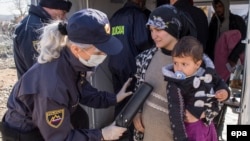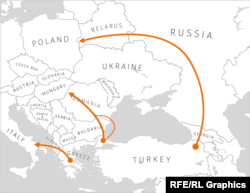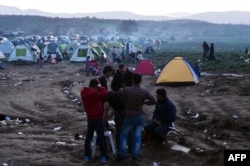Hundreds of thousands of people fleeing war and poverty have journeyed through the Balkans to reach Western Europe in the past year. Now the route is being choked off, leaving it unclear where the migrant crisis goes next.
Here are five things to consider.
1. End Of The Road
The Balkan route is being choked off as Austria and four Balkan states (Slovenia, Croatia, Serbia, and Macedonia) have set up their own quota system for how many asylum seekers and economic migrants will be allowed to move north from Greece deeper into Europe.
Vienna took the lead by deciding in February to admit only 80 asylum seekers a day, to accept a maximum of 37,500 this year, and to limit the number of people transiting through Austria to Germany and elsewhere to 3,200.
ALSO READ: 'We Will Never Go Back': Greece's New Purgatory
The four Balkan states followed suit by limiting the number of migrants entering their territory to 580 a day. They justified the limits by arguing that thousands of migrants, prevented from passing to other states, would become stranded on their territory.
Austria and the four Balkan states coordinated their actions through a meeting of their police chiefs, creating a unilateral response to Europe's migrant crisis rather than waiting for an EU-wide solution.
2. Migrants Left Stranded
The choking off of the Balkan route leaves some 22,000 migrants backed up in Greece, with 2,000 more traveling across the Mediterranean daily.
Greece is furious with the unilateral decision by Austria and the four Balkan states, saying it deliberately turns the migrant crisis into a "Greek problem."
INFOGRAPHIC: Map Of Alternative Refugee Routes
Greece, whose economy is struggling amid a continuing debt crisis, is among the European Union's worst-equipped for dealing with thousands of refugees.
That means the migrants need to move on. The question is to where, and how.
3. Detours To Schengen
The choking off of the Balkan route could send thousands of migrants looking for new routes into Europe.
One possible new route would be across the Greek border to Albania, then across the Adriatic to Italy. Albanian criminal groups regularly smuggle contraband across the water to Italy; now they could turn to people trafficking.
Another route could focus on Romania. Migrants could move by land from Turkey through Bulgaria to Romania, or go by boat from Turkey directly to Romania via the Black Sea. The goal in both cases would be to reach Hungary and enter the Schengen Area.
A third possible new route is across the Caucasus and then through Russia and Belarus to Poland. Poland, too, is in the Schengen zone.
4. Brussels In A Bind
The European Union has been left flat-footed by Austria and the four Balkan states' unilateral choking off of the Balkan route.
The measure comes as the EU seeks a unified solution to the migrant crisis that focuses on persuading Turkey to reduce the movement of people across the Mediterranean.
Under a deal struck between Brussels and Turkey in November, the European Union has pledged to provide an initial 3 billion euros to Turkey to help it house and care for the some 2 million refugees in the country. In exchange, Turkey is increasing patrols in the Aegean Sea with support from NATO and has agreed, starting this year, to take back migrants whose asylum claims are denied by EU states.
As tensions over the migrant crisis have risen, however, many EU states have simply set their own policies rather than wait for Brussels.
Austria's decision to limit its number of asylum seekers has drawn stinging criticism from Brussels, but Austria is hardly the first. Hungary took unilateral action last year in building fences along its borders with Serbia and Croatia; more recently, Prime Minister Viktor Orban ordered the country's defense and interior ministries to begin preparing defenses on its border with Romania, too. And an EU effort to get all its member states to share the refugee burden through a relocation system was undermined by the refusal of four Central European states to participate.
5. European Attitudes Harden
During 2015, more than 1 million migrants, including from the Middle East and Africa, entered Europe. This year, the numbers are expected to increase. During the first two months of this year, 131,724 migrants have crossed the Mediterranean Sea, nearly as many as in the entire first half of 2015.
As the migrant influx has continued, Western European states that are the main destinations have said they cannot continue to absorb such numbers of people. They have vowed tougher screening of asylum seekers to separate them from economic migrants.
Germany, which has received the bulk of the migrants, has expanded the list of "safe" countries to which rejected applicants can be returned home. Sweden has said about half of the migrants it received last year will be repatriated, while Finland has said it will do the same for two-thirds. Several Central European countries have said they do not welcome migrants or, in the case of Hungary and Slovakia, prefer only Christians.
Yet Europe also wants to remain a place of refuge for people fleeing their home countries out of fear of persecution or threats to their lives. The question now is how Europe will balance its desire to help refugees with its fear of too many migrants.
So far, no answer is in sight.













